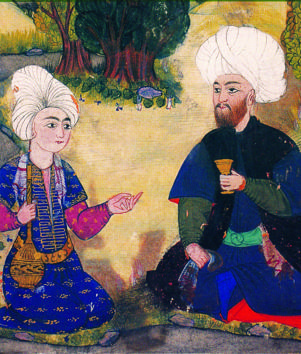Male sexual quirks among the Ottomans
NIKI GAMM
 “Your airs have turned my head! Say, who has brought you up so impudent?
“Your airs have turned my head! Say, who has brought you up so impudent?That stature by no cypress rivaled, who planned its development?
Your tender body in respect of scent and color’s choice and pure,
‘Twould seem ‘twas at the breast of some rare rose that you found nourishment.
You come, O vintner’s lad, a rose in hand, in the other wine;
Which shall I choose? Is it the rose, the wine or you will give content?”
[Nedim, in “The Penguin Book of Turkish Verse”]
Nedim, who lived at the beginning of the 18th century, was one of dozens of Ottoman poets who openly expressed their interest in persons of their own sex. But what was this interest? The first interpretation that leaps to the modern, western mind is homosexuality and sexual activity (sodomy).
But a serious look at Ottoman culture, and before that, Islam provides quite a different picture.
Until the modern era, there was no word for sodomy in Arabic or Persian. Nor is there any prohibition of it in the Quran. Some make reference to the destruction of the town identified as Sodom of the Old Testament (which is supposed to be the origin of the word sodomy) in the Quran, Surah 15: 73-77 as if it were the source. But it is quite clear that the city was destroyed because its inhabitants refused to offer hospitality to strangers. Where does the prohibition against sodomy come from? The reference is to some hadith, the sayings and acts of the Prophet Muhammad, which the Sunni interpretation of Islam uses to provide a legal basis for legal matters not covered in the Quran.
A recent article by Elyse Semerdjian that dealt with cases brought before the shariah court in Aleppo over a period of 359 years when it was under Ottoman control has turned up four, but only one concerning sodomy against a young man and his mother. The youngster is supposed to have brought men known to be involved in sodomy to his home to the anger of the people of his neighborhood. The two were expelled from their community, a customary punishment for prostitution that had become noticeable enough to disturb the neighbors. Sodomites, on the other hand, were not punished.
Leaving aside the issue of sodomy, which was interpreted as prostitution, but little punished and hardly respected, throughout Middle Eastern literature, there are many expressions of male admiration of males and in particular young boys. In the latter case, it should be noted that boys as young as 7 were considered in Ottoman society to be old enough to leave the harem to go to school or be apprenticed or, at least among the poor, work. Those youngsters who were “beardless, smooth-cheeked, handsome and sweet-tempered” attracted the attention of older men who had a higher position, more money, power, etc. The relationship was a close one including holding hands, arms over each other’s shoulders, even kissing but would lack an overt sexual component. This attraction would last until puberty when the boy would start to grow facial hair, in other words, became a man.
As long as the relationship lasted, the older man was expected to pine after his young beloved, shower him with expensive clothing and even buy him a house and other presents. The beloved, on the other hand, would behave in a capricious manner, employing various methods of shredding the lover’s emotions and making him uncertain of the continuity of the relationship and its final outcome.
On a spiritual level
 At the same time that one can interpret Ottoman poems as referring to real people, the lines also refer to the sublime. The beloved was God and the lover was the person who was attempting to achieve unity with God. “The Ottomans [also like the Europeans] inherit a long tradition of the spiritualization of love. That is to say … that a line of thought is broadly recognized that concludes that sexual desires or attractions are the physical manifestation of the soul’s yearning for return to a divine unity from which it was separated by birth into this material world.” [Walter G. Andrews and Mehmet Kalpaklı, “The Age of Beloveds”]
At the same time that one can interpret Ottoman poems as referring to real people, the lines also refer to the sublime. The beloved was God and the lover was the person who was attempting to achieve unity with God. “The Ottomans [also like the Europeans] inherit a long tradition of the spiritualization of love. That is to say … that a line of thought is broadly recognized that concludes that sexual desires or attractions are the physical manifestation of the soul’s yearning for return to a divine unity from which it was separated by birth into this material world.” [Walter G. Andrews and Mehmet Kalpaklı, “The Age of Beloveds”]This sentiment is related to that expressed by the members of the Sufi or mystic orders, which included many of the most powerful men in the Ottoman government and possibly the sultan himself. Some of the Sufis even organized what were known as “sema” during which ceremonies, they would sit in a circle and concentrate on the beautiful young boys in the center, concentrating to such an extent on what they perceived as beauty that they might fall into a trance. Since these ceremonies often lasted all night, the people who were opposed to these mystic orders were quick to accuse the participants of engaging in sodomy. As early as the 9th century these sema ceremonies were held and two centuries later they were condemned by orthodox conservatives as showing that the Sufis were engaged in heresy. A 17th reformist movement in the Ottoman Empire condemned this boy-gazing as heresy and equated it with sodomy even though the physical act itself had not occurred.
What has been little studied is the issue of men wearing women’s clothing. Known as “zenne,” these men were in the public eye but it seems with little or no criticism. In the miniature depictions of festivals we see male dancers – it would have been impossible for women to have performed in public. And in the traditional Karagöz plays, one of the characters is a zenne.
It wasn’t until the 19th century and increased exposure to Western European ideas that homosexuality, or rather the open attraction of an older man with a younger one among the Ottomans, began to retreat into the shadows. Western ignorance of Ottoman culture led to many invented tales of what occurred in society; lurid and fanciful stories were made up to shock and entertain western readers. Stories such as one about the women in the imperial harem dressing in male clothing in order to arouse the sultan’s sexual appetite were common.
















